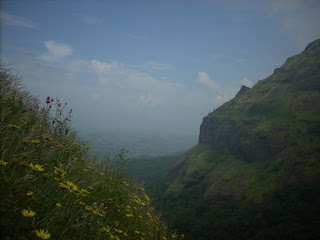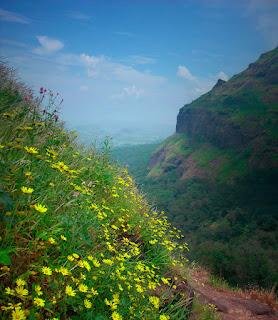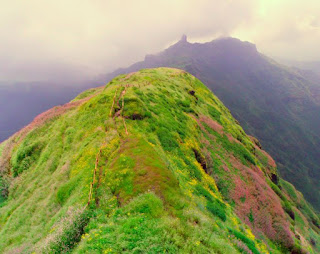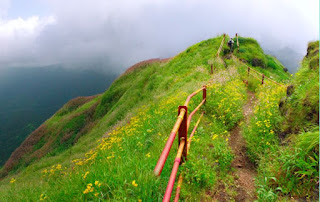I shall write about my recent trip in the Garhwal Himalaya. Occasion was the Great Himalayan Bird Count 2009 (7th-10th Nov 2009). It was being organized by an NGO called ARCH (Action Research and Conservation in Himalaya) which is headed by a dynamic person named Prateek Panwar. I came to know about the Count from Dr. Bharat Bhushan (Count Director), who is a well known Ornithologist and currently the Deputy Director (Environmental Planning) at YASHADA, and who has guided me in various bird endeavours in the past. I had asked many of my friends to join in the Count, but only Juhi agreed to come. Just a day before we left, I got my hands on a Nikon D80, its kit lens Nikkor 18-135mm, a Sigma 150-500mm OS and a Lowepro Computrekker bag. My friend Tanmay Mehendale readily gave this gear to me as he is planning to shift to Canon. Tanmay has done some phenomenal work with the Sigma 150-500mm and it obviously made me nervous to carry that monster lens (without doing any practice), into unknown lands in front of unknown people. Later on, it didn’t seem to be such a difficult thing to do.
We left Pune on the 5th Nov 2009 for Delhi by Goa Express. The journey was a little tiring and we had weird, though nice, company. There were three men- a Canadian, a Tibetian Monk and a Sikh in our compartment and witnessing their interaction and participating in the conversations (or attempts for conversation) was fun. In Delhi, we were received by Nitin, who took us to his place in Roop Nagar. He is by far, the best host I have seen amongst my generation! After freshening up, we went for a stroll in the Delhi University, where Nitin is studying for his Masters in English Literature. I was impressed by the University campus and certainly would have loved to pursue my higher studies over there. Travelling in Delhi Metro was a pleasure experience, except for the fact that we had to remove and re-wear all our luggage at every other boarding station, and the tough time I had while convincing the security personals at the X ray scan that the 150-500mm is a lens and not a gun!
A snap of a bldg in Delhi University
After reaching Dehra Dun on the 7th morning, we went to FRI Manthan where all the participants had come for briefing. We met interesting people like Dr. Sayyad Husssein, who is a well known senior bird watcher who used worked in BNHS along with Dr. Bharat Bhushan, Anil Kunte (who made a twitter bird clock), Narbeer (who has done some tremendous work on birds in Chandigarh), Rajesh Sachdev (moderator of various on-line groups dedicated to bio-diversity). Due to time constraints, I was unable to get acquainted with other equally interesting birders from all over India. Some of the participants like retired Wing Commander Mr. Narsimha, were new to birds, but were equally enthusiastic. The opening ceremony was a high profile one which saw speeches of high ranking Government minister and officials, and those by the Count Directors. It was interesting to listen about Jerdon’s Courser from Dr. Bharat Bhushan, who rediscovered the bird after 138 years. The ultimate aim behind such counts is to rediscover the Himalayan Quail (Ophrysia superciliosa), a legendary bird presumed extinct since 1876. Coming back to the Bird Count; 16 groups were scheduled to cover almost the entire Garhwal Himalaya.

I was in Group 5, which was scheduled to go to Yamunotri via Barkot. I was excited about the thought of seeing snow clad peaks Himalaya. Our group comprised of Dr. Bharat Bhushan (who was kind enough to make me the leader, thus to bear the hateful task of waking up the group before dawn), Kalpesh Patel; a chemical engineer working in 3M, who became a thick friend by the end of the count, Juhi, who’s an English trainer working with Symbiosis, but a naturalist at heart, and who has got keen vision so useful for spotting birds; and myself. Well, I have some background in environmental science, lesser so in geology, even lesser so in ornithology (study of birds) and odonatology (study of dragonflies).
A view from a roadside Dhaba, near Mussoorie
Finally by 1.45pm we were off to Barkot in a Count vehicle (Mahindra Commander) along with the equipments provided by ARCH (previous year’s Bird Count report, worksheets, First Aid kit, Banner etc). We took our first hault before Musssoorie, at a roadside dhaba to have lunch. Outside the dhaba, the sky was clear and I got a good composition of the distant houses on a hill top with mountains in the background. Learning camera functions of D80 proved to be difficult. As I didn’t have the manual, I had to figure out things from my own. Nikon proved to be counterintuitive for me. Seldom did I get some function right. Even the mount rotating action to remove and attach lenses is also opposite to that of Canon and Pentax. Worst was the button to be pressed for removing lenses. It needs to be operated with left hand. Now, the left hand is always holding the lens and hence in order to press the button, one needs to leave the lens which causes imbalance. It was worst because I had to constantly shuffle between the 18-135mm and the 150-500mm. A pain in a$$. As other functions like the L switch remained alien to me, I decided to operate with minimal settings. I shot everything in the A priority mode, AF-S, central crosshair, Burst mode, Single AF point selection, ISO 100 or 400, NEF wherever possible, otherwise Fine or Normal quality Jpeg. I quickly learnt to keep the exposure compensation to -0.3 (thanks to clipped highlights Playback). The lens 18-135mm is simply superb! I didn’t find the need of VR while I used it. Working with it was superfast. The Sigma lens was another story. It rarely gave me a sharp photo, but I was using it under extreme conditions of light and I was new to the lens as it was to me. I hope the more time we spend together the better it is, for both of us.
A view during the drive to Barkot
We reached Barkot by night, thanks to skilful driving by Sunil, the Count Vehicle driver. On the meandering roads across the mountains, you are totally at the driver’s mercy. Thats why the Pahari people (people from the mountains) refer their drivers as “Driver sahaab” or even “Pilot”. At Barkot we had a simple yet delicious dinner at a small hotel run by Mr. Rawat. While going to the Forest Rest House of Barkot, I sighted hind legs of some animal. It turned out to be a Jackal. It appeared that there is a pack of them living in the vicinity of the Barkot FRH. We had multiple sightings of them. That is all to be told for the 7th.
A view from Barkot FRH
Kalpesh Patel, whose tremendous bargaining skills made this tour a real value for money! :-)
The dawn on the 8th witnessed the start of our bird count. We decided to wake up early and go for a walk at 5am. Unfortunately, we didn’t spot anything. Neither bird nor mammal. It was when we returned to the the FRH, i.e at 6.15am, that we opened our Count account. Enter Asian Barred Owlet. It was perched on a tree right in front of the FRH entrance, only to be chased by the Blue Whistling Thrush. BWT, we had seen during our way to Barkot and it is a pretty common bird to find in this area. Across the world, there are always species which replace other species found in a different geographical location and which performs similar functional. In simpler terms, two species, same niche, different locations. E.g the role of top predetor in the jungle is performed by the Common Leopard, the Jaguar, the Snow Leopard etc. Similarly, the Blue Whistling Thrush seems to replace the Malabar Whistling Thrush found in the Western Ghats. Similary, the Asian Barred Owlet might be replacing the Spotted Owlet of the peninsular India.
Asian Barred Owlet
Bharat Sir, all ready for chai
The next interesting bird we sighted, minutes after the Owlet, was the Grey-headed Woodpecker. It was a large woodpecker busy in its trademark activity- woodpecking. It limited itself to the tree stock close to the ground, say till 1-1.5m. All the woodpeckers I had seen earlier were smaller in size and were always sighted high in the branches. Unfortunately, I got nothing but blurred photos of the GHW, useful only for its documentation. Next came a flock of Red Billed Blue Magpies, which Juhi spotted. They were playing in the hay stacks, kept on a platform created in the trees. They seemed to busy eating the berries as well. The Grey Treepie also gave us a courtesy call and so did a Tree-creeper. We later identified it to be Bar-tailed Tree-creeper. We saw plenty of tiny warblers like birds but could not identify them then. After having a heavy breakfast of the best Aloo Paranthas in the world (at Rawat’s modest hotel), we set off for Yamunotri.
Pine plantations
We were supposed to walk a 10km transect and then continue the journey by the CV, but as the sky was exceptionally clear, Dr Bharat Bhushan suggested we go directly to Yamunotri and carry out the transect during return journey. We did stop a couple of times to sight a Long-billed Vulture, a White-capped Water Red-start, a Crested Kingfisher and, more importantly, to have chai, which I call the elixir of life! The fact that I am a tea-addict was quickly learnt within the group and was respected too, by frequent tea-breaks. Other group members were also avid tea lovers. Besides, one is seldom too disciplined to not have tea in the Himalayan cold.
River Yamuna
Crested Kingfisher waiting for its next meal
It was 1.45pm when we reached Jankichatti, the place where the motor-able road ends. As most of you must be aware of, Yamunotri is a well known piligrimage site for the Hindu. Yamunotri, along with Gangotri, Badrinath and Kedatnath, constitute the Chardham yatra. The hills are named such that a piligrim would eagerly walk, knowing that he is coming closer to the all mighty. First hill to come is chatty. It is followed by Ranachatti, Poolchatti, Hanumanchatti, Jankichatti, Bhairavchatti and finally the Yamunotri.
First view of Kalanag and Bandarpoonch peaks
A view of the splendid mountain peaks: the Bandarpoonch and Kalanag
We were greeted at Jankichatti by an exceptionally large gliding bird. It was by far the largest bird I’ve seen in the wild. It was not a vulture. There were two Himalayan Griffons following its route, but this bird was much larger than them, had a longer, noticeable tail and a wing span not similar to the vultures. Also, its flight was unique. While the vultures were hovering at their usual, boring speed, this bird was fast and was heading towards a cliff in a linear direction. Nor once did it flap its wings. Inspite of this, its speed was astounding. As if the wind was empowering it. But then the Griffons were so slow. For a moment, none of us spoke. We were literally transfixed by it. It was sheer overpowering. I was, unfortunately, carrying the smaller lens, and had to shoot with it. Once I got the documentation shot, I frantically opened my bag for the Sigma 150-500 but till then the bird was gone. And so had the Griffons. Once we met Dr. Bharat, who had gone to search for the FRH, I immediately showed the photos to him. His face lit, met Dr. Bharat, who had gone to search for the FRH, I immediately showed the photos to him. His face lit, yet he refused to identify the species. He asked me to search the bird guide. Searching for an unknown bird in the Book of Indian Birds is a game I always loved. Its not the same wwith the Grimmett book. With additional species, changed names and too many illustrations, I find the Field Guide to the Birds of the Indian Subcontinent less pleasurable to read. (However, I agree, handsdown that it is more useful than the BOIB, especially when it comes to the distribution and the plumage variation). Our bird layed on the Plate 61. We had sighted the legendary Lammergeier. Lammergeier is known to feed on the bone marrow. It keeps close to the vultures while they scout for the deads. It then waits patiently till the vultures have their stomach ful (of Dactlophinac?!). Then it carries a nice big bone from the caracass and flies at a high position. From there, it drops the bone on to the hard ground where it cracks open and thus the Lammergeier can feed on the marrow. Exciting? Hell yes!
A documentation image of the Lammergeier
The staff at FRH Jankichatti was exceptionally warm. Actually, every pahari person I have met till date, has been exceptionally warm at heart. Whether the area is Kumaon, Khasi or Garhwal, this virtue is hard to miss. These people seem to be made of some different breed. Raised in free spirits, unpolluted in every sense.
Our group and the staff at Jankichatti FRH
A kid from Kharsali
Himalayan Griffon over Yamunotri glacier
We had to quickly start our 5km trek from Janki chatti Yamunotri shrine because delay would put our return in jeopardy. Strange course of events, in which I won’t delve, saw us climbing the Yamunotri without food and water. Food was not an issue. Water was. It always is. We reached the temple in 3.5 hours. We sighted birds like Alpine Accentor, Snow Pigeons, Himalayan Woodpecker and a pack of Hanuman langoors. The temple of Yamunotri was almost empty, except for the head pujaari (priest) and a few caretakers of the temple. Constrcution work for the bridge to the temple was on-going, hence a few workers were present. Apart from that, there was nothing. Not even the shrine. Every winter the temple authorities take the goddess down to a village called Kharsali. We saw a hot water spring called Surya Kund over there. It was so boiling hot that people cook potatoes in it and give it as a Prasad to the devotees. The water from the spring is let into two pools, one for gents and the other for ladies. A dip in them is a very good practice, not only because it is considered holy, but also because it takes away all your fatigue and refreshes you like anything. People asked me to jump into the pool meant for gents and I readily agreed. The instant before I was about to jump, I thought it would be good if I check the water first. Hence I dipped my feet inside, to check how hot the water was. The next instant, i was out of the pool, ailing my burnt legs! How can anybody take bath in water so hot? Localites said I overfelt the heat because of the cold. Hence I repeated the feet test after few minutes of allowing them to get ‘acclimatized’. Same result. I felt very stupid, being only on chaddi and too afraid to dip. The temperature was around 2 Degrees C and I was freezing. However, Kalpesh was soon to face the same problem. J . Localites, gleefully, suggested us to take bath in the tank meant for ladies. The water in that pool was being mixed with cold water, and hence was less warmth. Unashamed, we made a run for the ladies pool and were relived to find it perfect! Next few minutes were the happiest ones in quite a while. I can still feel the warm water touching my whole body. Ultra relaxing. The contrast between the warm water and the atmospheric cold was mind boggling. Being a Geology graduate, I had read a lot about geothermal energy, but experiencing its true potential was truly memorable. A spot like this has to have a temple around it, for it is truely God given. By climbing steep mountains, by challenging the tough cold and then experiencing the rewards of such hot bath, makes you think spiritual by default!
Yamunotri Temple, right in the river channel
It was already dark when we left the temple for the return trek to Jankichatti. We had a forest guard with us. However, he was cursing us for coming atop so late and now leaving in the dark. He was afraid of the leopards. Juhi was, like always, equipped for the worst. She had two torches and the her cellphone, Samsung B2100 Marine, is meant for such harsh environment. The torch it emitted put the other torches to shame and it became our main soruce of light. The road was narrow, with steep cliffs on one side and the valley on the other. It was constantly turning. Such turns would provide such perfect ambush for a man-eater! I dared not to think. Yet I kept imagining from the Corbett stories I have read so many times. The thought that “This is Garhwal, not Kumaon” provided a little comfort. The guard was telling us to make as much noise as possible. Hence there we were trying to talk. Strangely, none of us could think of any topic worth talking. Funny, life is. We were tapping the walking sticks to the side railings. We came past one of the river bridge. Such areas are more unsafe, said the guard. When we were relieved after crossing the bridge, he said the real danger is ahead, the area where the government had planted a lot of trees. And he was right. At the edge of the Samsung’s light, Juhi saw a pair of eyes flash. She nudged me and I saw too. Not the shining eyes, but a dark silhoute. Though I had never seen a leopard in my life, I had seen enough of it on media to identify one. Unmistakably, this was one. But what struck me was the speed with which it moved away from us. The movement was beyond anything. How can so large a body move so fast, so suddenly, so silently? That movement would put all my wildest imaginations from wildest dreams of putting up a decent fight against such beasts, to rest. Forever. By the time Kalpesh came to know of it, it was gone. The guard, however, had seen it and didn’t say a word after that. He didn’t have to. Once we came in thee vicinity of Jankichatti, we all relaxed. Cheerful once again, we reached the FRH. The sky was beautiful. The stars and the moon had come out and had gently lit the whole area. I knew I could get some once-in-life time astrophotography shots. I had everything needed for them: a beautiful DSLR with a wide angle lens, a mini yet sturdy tripod and, more importantly, an exceptionally beautiful sky. But, I am ashamed to say, laziness got better of me. Yes, I hid behind the excuses of the air being too cold and me being too sleepy. I still feel the pinch, but there’s nothing I can do about it now.
A typical Garhwali house at the backdrop of the glacier
Next day (9th Nov) turned to be a spoiler. The sky was overcast and gloomy. We went to Kharsali, the hamlet where the shrine was kept. After searching for temples and asking a few localites, we came to the house belonging to a priest, where the shrine was kept. We had darshan of the goddesss, performed Pooja and were allowed to take photographs too. This fact and the hot water bath made me believe that the best season to visit Yamunotri is off season, provided you are able to get permission to go there from the Government. We saw a mixed pack of Crows consisting of Broad-billed Crows and the Carrion Crows. Bharat Sir and Juhi were lucky to spot Yellow-billed Chough. I might have seen one too, but discounted it thinking of a Broad-billed carrying some food item.
A mixed flock
Minutes after we left for Barkot, it started drizzling. If we had followed the schedule, we would have witnessed snow fall at Yamunotri. However, it would have become too cold for the clothes we were wearing. Morale of the story: Always use your common sense, even if you are given a schedule to follow J. We couldn’t complete much of the transect that we had planned from yamunotri to Barkot. We however, took breaks at the gulley crossings which resulted in spotting birds like Blue-capped Water Redstart and multiple sightings of Spotted Forktail. Juhi spotted a few Common Wood Pigeons perched on the Pine trees. Once we reached Barkot, we had good discussions on every species, with Bharat Sir checking and rechecking every species I captured with the Grimmett field guide. After that, we compiled the Count report.
Snow Pigeons
The morning of the 10th was memorable. For one thing, I learnt from previous mistake and wokeup at 6 instead of 5. Within minutes, I had seen a Fire-brested Flowerpecker, a Yellow-bellied Flycatcher, a Niltava, and a Whiskered Yuhina! Unfortunately, I couldn’t take a single decent photos of them, got documentation shots of all. Not that these are rare birds over there. Its just that seeing 4 lifers in 4 minutes was too much for me.
After we went back to Manthan, Dehra Dun, we attended the closing discussion where all the groups gave an account of their sightings. Well known theatre film personality Mr. Tom Alter was present too. And so were many big names in the forest department.
I continued to stay in Dehra dun after 10th till 13th. But I shall write about it some other time.
I would like to end this post with a splendid view from the Barkot FRH




































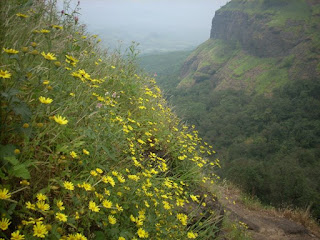 The Foreground shot
The Foreground shot 